Turn back the clock several years and only a handful of distilleries were operating in Tasmania. Now there are more than 80, with about 35 of these making whisky. Of course, it all began with pioneers Bill and Lyn Lark, who succeeded in overturning an 1839 law banning distilling in Tasmania and went on to establish hugely successful Lark Distillery. Interest in Tasmanian-made spirits has continued to grow, with many of our state’s top-quality whiskies – crafted using some of the cleanest air and water in the world – attracting the global spotlight as they continue to win a prestigious international awards. We may be a small island at the bottom of the world, but Tasmania actually produces 1 per cent of the world’s whisky. As Tasmanian Whisky Week (taswhiskyweek.com) approaches – with 22 events bringing together about 35 distillers across the state from August 8-14 to celebrate 30 years of distilling in Tasmania – we talk to four industry players about the growing popularity of whisky, what it takes to produce a good drop, and why they are so passionate about making – and sharing – spirits made in their home state with the rest of the world.
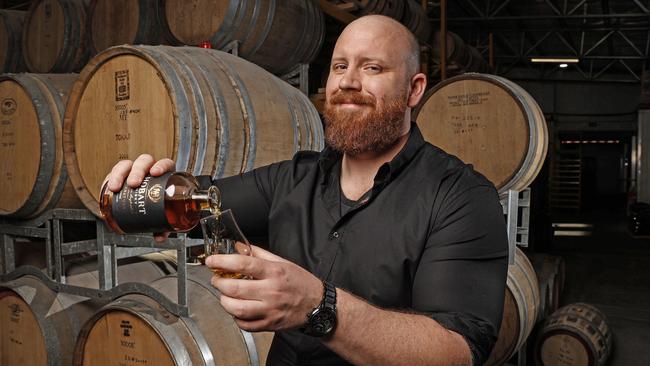
JOHN JARVIS
HOBART WHISKY
If there’s one thing that making whisky has taught John Jarvis, it’s patience.
The 37-year-old from Glenorchy manages Hobart Whisky distillery (hobartwhisky.com.au) in Moonah and says creating top-quality whisky requires a significant commitment of time, energy and skill.
“By nurturing these casks, and even when it’s out of the cask, it’s such long-winded process to get it in the bottle because we’re striving for perfection,’’ he says.
“It’s a double-edged sword because what is perfection? Everyone’s interpretation of a perfect whisky is very different. And you have to be patient – it’s a patience game.’’
The distillery was established in 2014, and began distilling in 2015, with its first whisky release in 2018.
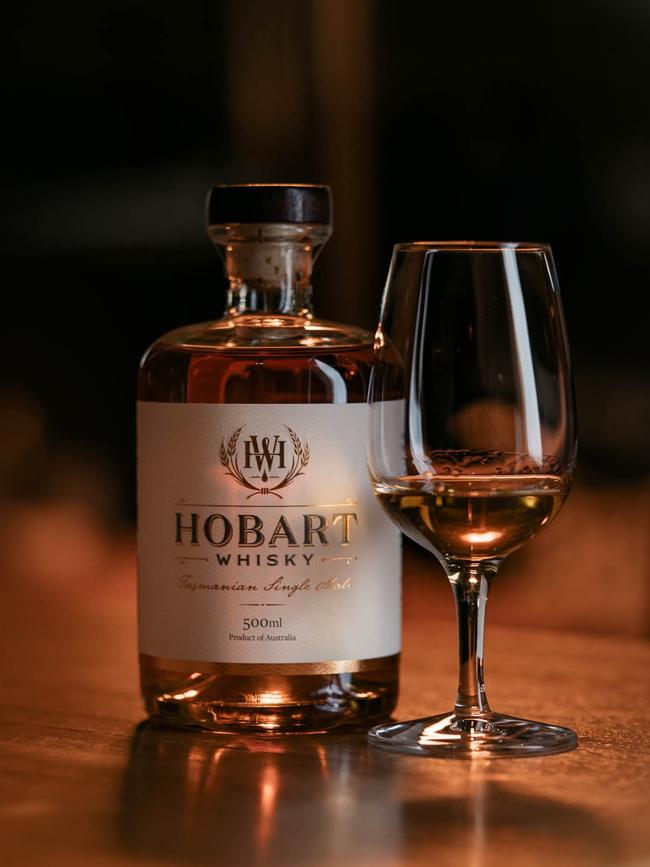
The business initially operated under the name Devils Distillery before becoming Hobart Whisky.
Jarvis spent 20 years working in graphic design and marketing before making the switch to managing a distillery.
He initially expected to be “on the tools” and running the still, but quickly discovered his skills were better placed developing brands and products and managing people, so he now works closely with head distiller Ben James.
“The philosophy of the businesses is based around the idea of making whisky for us, that we love, and want to share,’’ Jarvis explains.
“We are very lucky that we get to make whisky we enjoy and then sell it to other people who might enjoy it.’’
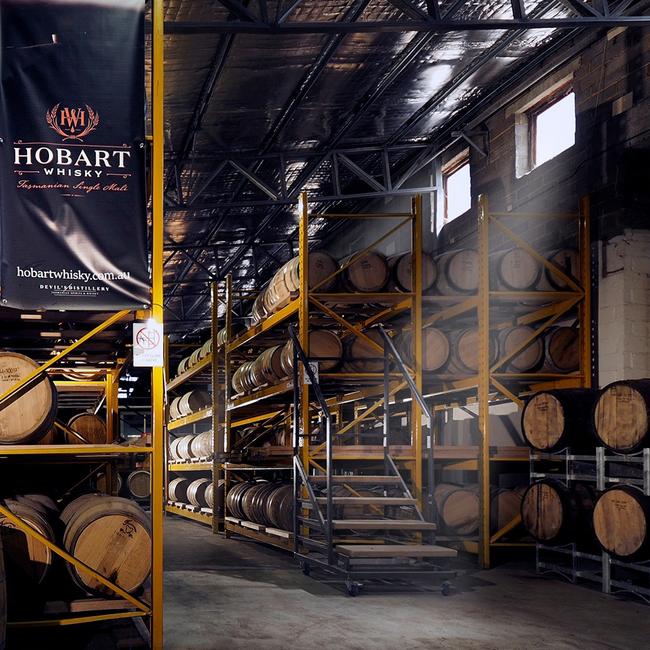
The distillery doesn’t have a cellar door or run tours, so public events like Tasmanian Whisky Week are crucial for capturing consumer attention.
“Events like Tasmanian Whisky Week, the Taste of Summer and Winter Feast – we get in on all these events, and we meet so many new people who haven’t heard of us,’’ Jarvis says. “Our limited releases sell out in a couple of days, so many people don’t get to hear about us.’’
He says when the distillery began it was one of only about 10 in the state. But it is great to see the industry booming in Tasmania.
“I think we were one of the first 10 distilleries in Tasmania when we got our manufacturing licence,’’ Jarvis says.
“And there are more than 80 now.

He says there’s great camaraderie between whisky distilleries.
“Whisky itself is a great industry,’’ Jarvis explains.
“We all get along, we catch up and share drams and stories. There’s no real competitive edge, we all understand that there’s enough market share for us all to exist and it’s in our best interest to work together.
“The previous industry I worked in was horribly competitive and everyone was out for themselves, so this is a breath of fresh air.
“I’ve made such good friends … it’s great to have the opportunity to meet people through the product and say ‘we’ve made this product and we love it’.
“I feel very fortunate that I have this platform where I can make a product and can stand back and say ‘wow – I love this’ … and then I get to share it with others who really enjoy it.’’
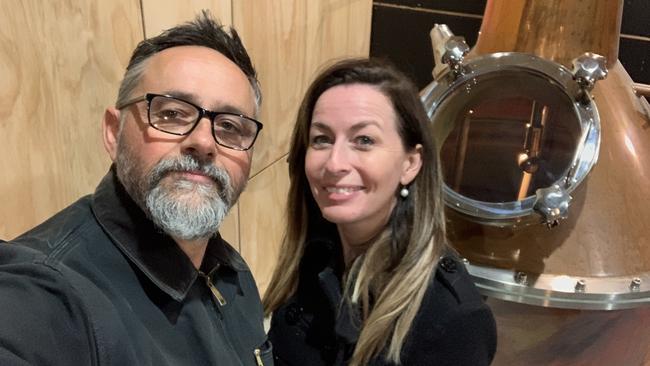
DALE WILLIAMS
WELLINGTON PARK DISTILLERY/
EDEN WHISKY
Tasmanian Whisky Week is going to be extra exciting for Dale Williams.
The 52-year-old started Wellington Park Distillery on 9ha of land on the edge of Wellington Park at Collinsvale about five years ago and is finally ready to launch his very first Eden Tasmanian Single Malt Whisky (edenwhisky.com.au) as part of Tasmanian Whisky Week at an event in Hobart on August 11.
“We talk about capturing the spirit of the mountain,’’ Williams says.
“The key thing here is our water is gravity-fed from Mt Wellington. This farm has been drawing water (off the mountain) for the past 100 years as it previously operated as a berry farm. The water is literally snow that melts off the mountain.
“The water has been laboratory tested and it is incredibly soft, clean and pure. It is perfect for brewing and whisky dilution.’’
The business is run by Williams and his wife Claire, while local artist Sam Lyne has been commissioned to create illustrations for the whisky bottle labels.
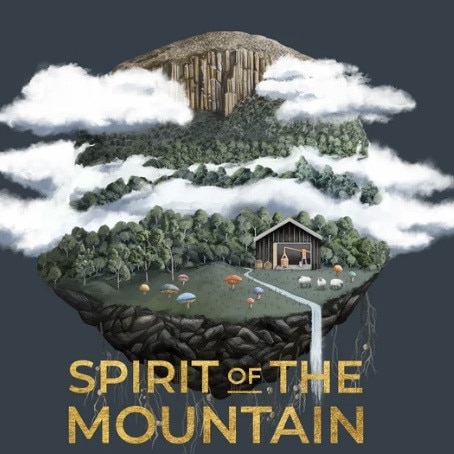
Williams spent many years employed as a social worker before trying his hand at distilling.
“I was ironically working in drug and alcohol counselling,’’ he says.
“I needed a life change, really.’’
He became interested in Tasmanian whisky and after a chance encounter with a Tasmanian distiller – who encouraged Williams to try making spirits of his own – he decided to give it a go.
He designed his own still and had it made. He did a lot of reading and research and undertook training courses, before putting his new-found knowledge to the test. Tasmanian whisky is left to mature in the barrel for a minimum of two years, so it’s not a quick process. It takes a while to find out whether what you’ve created is any good.
“Basically you are pouring lots of money into making a product that you won’t have released for a couple of years,’’ Williams says.
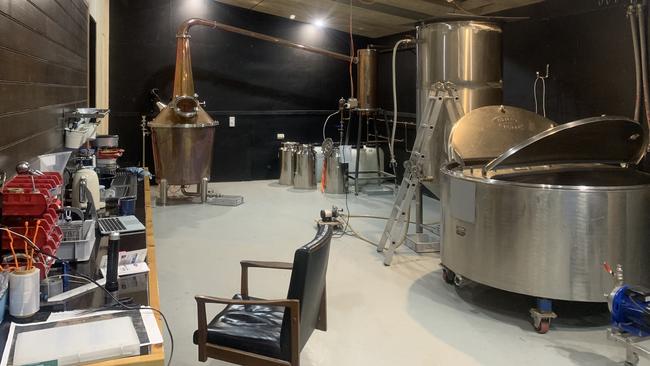
He enjoys the process of experimenting with different ingredients and processes.
“I often refer to it as a science experiment that you can drink,’’ he says.
Williams’ Eden new-make spirit – the clear, high-proof alcoholic liquid that comes off the still during spirit production, before it goes into the cask for flavouring and maturing – won a silver medal at the World Whiskies Awards earlier this year
“It’s been absolutely amazing, I’ve loved it, its been exactly what I needed,’’ Williams says of his career change.
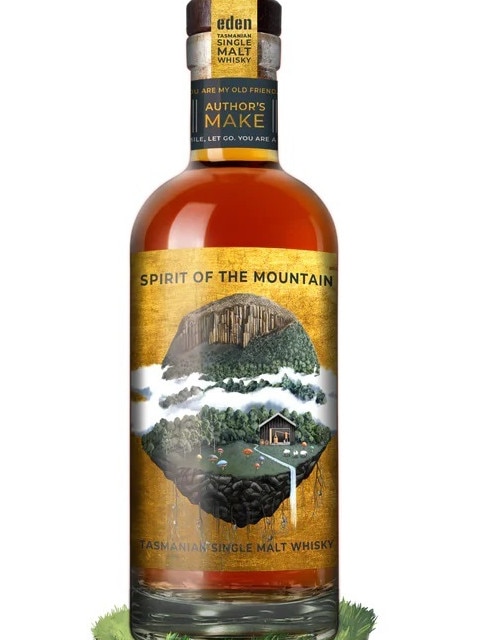
“I haven’t just been making whisky, I’ve been setting up the distillery, and all the other skills as well. To make that happen and then learning the brewing process and distilling process and playing with that, it’s a very tactile experience. When you’re mashing in barley, putting milled barley into a vat of hot water and just the smell of the barley and the sugars and the sweetness of that. Then there’s the taste and the smell of the spirit coming from the still and the casks – all of that is really just an enjoyable process.’’
And of course tasting his whisky, and being able to share it with others, has been a highlight.
“The whisky is sensational,’’ Williams says.
“I know that I have a slight bias. But the feedback has been excellent.
“So I’m super excited that it’s sitting there (ready to go on sale to the public).’’

KATE AKMENTINS
TASMANIAN WHISKY AND SPIRITS ASSOCIATION
As executive officer of the Tasmanian Whisky and Spirits Association, and the organiser of Tasmanian Whisky Week, Kate Akmentins is well connected with the state’s whisky distillers.
There are now about 80 distilleries across Tasmania – making all manner of spirits – and 96 per cent of those are members of the Tasmanian Whisky and Spirits Association.
And about 35 distilleries will be showcased at events during Tasmanian Whisky Week, an annual festival which has grown enormously since it first began in 2016, when there were only about five distilleries involved.
It’s a reflection of the Tasmanian whisky industry more broadly, which Akmentins says is growing about 20 per cent a year.
“Employment has grown about 30 per cent a year as well,’’ she says.

Interestingly, Akmentins doesn’t make her own spirits, she’s actually a winemaker.
She owns Petrichor Wines at Tea Tree in the Coal River Valley, a biodynamic vineyard that she established in 2017 and says there are certainly crossovers with the spirits industry.
Akmentins, 49, became involved with the Tasmanian Whisky and Spirits Association and Tasmanian Whisky Week in 2020, just before Covid hit.
Some events were still able to run during the pandemic, including a virtual whisky tasting session conducted over Zoom.
But she says this year the festival is back to full capacity and will include the largest program of events since the festival began, with 22 events around the state, held between August 8-14.
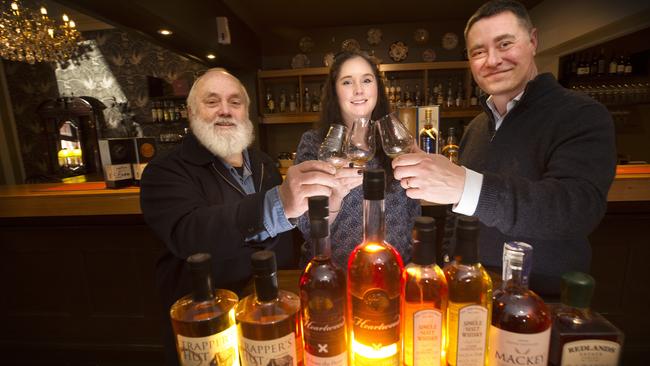
About 1600 patrons will attend the festival, and most events will be sold out.
The festival typically attracts about 50 per cent of interstate patrons, with the other half hailing from Tasmania.
There will be whisky workshops and tours, meet the maker events, comedy and drams nights, a Story Slam open mic night where six distillers will verbally battle it out to be the best storyteller, and a dinner with chef Analiese Gregory at Killara Distillery, at Richmond.
The festival culminates in a Tasmanian Spirit Showcase at Princes Wharf 1 on Saturday August 13, from 2-5pm and 6-9pm, where about 35 spirit makers will showcase whisky and other spirits.
Another highlight is the Gala Dinner at Hobart Town Hall on Wednesday August 10 where distillers will come together to dine with consumers and tell their story of distilling to diners at the table. Distillers will be dotted around the room along with distilling pioneers Casey Overeem from Overeem Whisky, Patrick Maguire who began Sullivans Cove Whisky, and Bill and Lyn Lark. This year marks 30 years of distilling in the state – it was 1992 when the Larks were granted the first licence to distil since 1839, becoming the first Australian distillery to produce single malt spirit in 154 years.
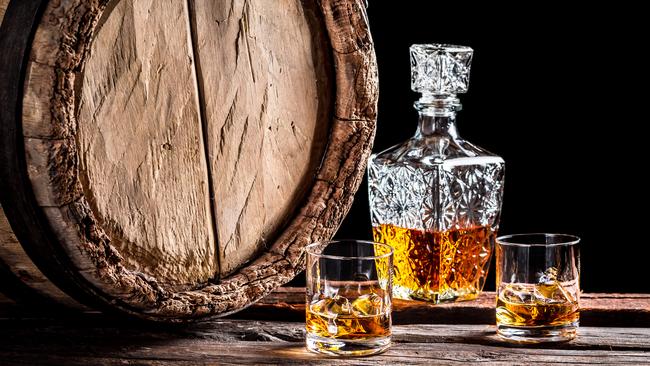
Whisky lovers who can’t attend in person can also set themselves up with a tasting pack and enjoy a virtual tasting event from the comfort of home.
Akmentins says one of the important roles of the Tasmanian Whisky and Spirits Association and Tasmanian Whisky Week is to get local products seen – and sold – on the mainland.
Many smaller distilleries don’t have cellar doors, so Tasmanian Whisky Week gives members of the public rare access to these distillers and their products, which are often made in small batches and sell out within days.
Tasmanian distillers use many local ingredients including barley, spring water and locally foraged botanicals.
Kristy Lark-Booth grows her own botanicals at Killara Distillery and has even planted oak trees so the Richmond-based distillery will eventually be able to produce its own oak barrels.
“Whisky Week is very much about Tasmania – the people, the place and the product – and people can try product and speak to distillers about why it does taste the way it does and hear them tell their stories,’’ Akmentins says.
“Some people just aren’t aware of how many distilleries are down here (in Tasmania) or why they are the quality they are, or why they get awarded as the world’s best whisky.
“They might know Lark, and Sullivans Cove, but there’s a whole other world of distilleries out there.’’
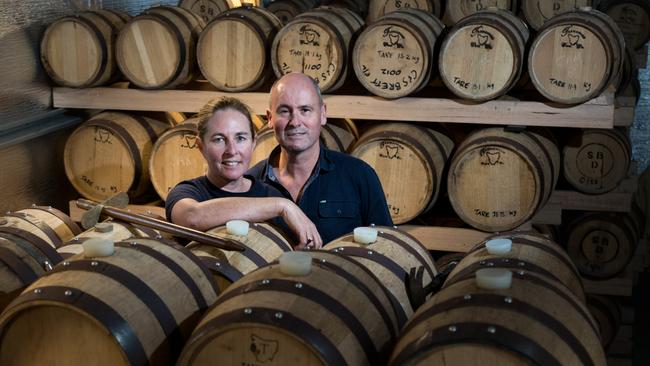
CAM BRETT
SPRING BAY DISTILLERY
Cam Brett had been working in the tourism industry – for Tourism Tasmania and TasVacations – for 25 years when an encounter with whisky pioneer Bill Lark led him to start his own distillery.
“We developed a tour that involved Lark Distillery,’’ Brett recalls of his TasVacations days.
“I met the Lark family … and I was inspired.
“My wife Suzy and I both share a passion for single malt whisky – she was born in Zambia then grew up in Ireland – and our first drink together was a dram of Jamesons.’'
In 2014 they made the decision to start a distillery.
“At that time there were only about seven distilleries in Tasmania, we thought it was quite a novel idea,’’ Brett says.

He and Suzy went on a fact-finding mission to Scotland with Bill Lark and other whisky heavyweights in 2015, visiting 23 distilleries in 15 days.
Bill Lark had been inducted into the Hall of Fame at the World Whiskies Awards in London the previous year – the first distiller from the southern hemisphere to receive the honour – while Sullivans Cove Whisky won the Icons of Whisky award for Craft Distiller of the Year and had also won the Best Australian Single Malt award for the third year in a row. A year earlier Sullivans Cove whisky was named The World’s Best Single Malt. So Brett says it was a “pivotal” time for whisky production in Tasmania.
The distilleries Brett visited in Scotland were mostly coastal distilleries, each with unique products and origin stories and he could see that this was “easily translatable to a distillery in Tasmania’’.
“It was quite an eye-opener, seeing the importance that a sense of place has on the whisky experience,’’ Brett says.
The Bretts had owned a shack on Tasmania’s East Coast for more than 20 years and knew that Spring Beach, near Orford, was the perfect spot for a distillery that could make the most of fresh rainwater which came with a special touch of natural sea salt.
Their distillery is less than 500m from the ocean.
“Most afternoons, sea mist drifts up the valley and falls on the roof of the distillery, later collected when the rain falls,’’ Brett says.
“This sea salt imparts a unique profile to the water which is both soft and sweet.
“Spring Bay’s approach to making single malt whisky ensures every part of the process has the highest quality application that can be achieved. The use of premium Tasmanian barley, the quality of the wash, the distilling, the careful selection of casks and importantly using arguably the best water in the world – East Coast Tasmanian rainwater.
“We know the rainwater there is the best we’ve ever tasted.’’
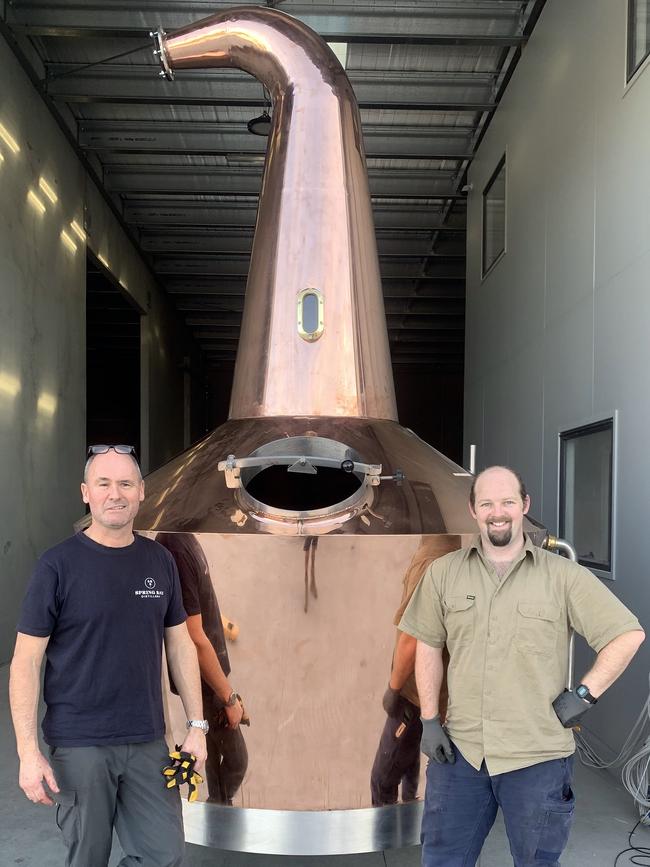
They run tours and tastings and Brett says he is definitely glad he opted for a career change.
His honours degree in science came in handy, and he also feels fortunate to be learning from Dean Jackson, his head distiller and distillery manager – who previously worked for Redlands Estate Distillery.
The Bretts have a house on the East Coast and another in Hobart and commute between their two distilleries at Spring Bay and Cambridge, making whisky, gin and vodka.
“We expanded into Cambridge in 2018 because we kept running out of whisky,’’ the 56-year-old says.
“Seven years in and Suzy and I are still both passionate, we love it.’’•

How close is the Tasmanian tiger’s return
The race to bring the Tasmanian tiger back to life is heating up after a scientific breakthrough has completed 99.9 per cent of the puzzle. Here’s why.
Liberals move quickly to elect new deputy Premier
There was only one candidate to replace the under-fire Michael Ferguson after he resigned from his portfolios. Here’s Tasmania’s new deputy Premier.